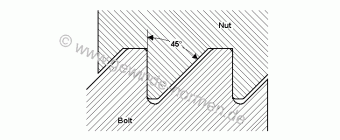Do these bolts ever need to come off? If so, can they be used again?
There might be a little confusion as to what is meant by “torque to yield” and the tightening of a bolt using some type of tool to actually measure the amount of stretch you are imparting on the length of the bolt in order to insure that it is imparting the proper tension on the joint.
Torque to yield bolts are specifically manufactured so that they are installed in an exacting procedure. You are using a predetermined amount of torque on the bolt so that it reaches but does not exceed the action manufactured yield strength of the fastener but approaches it. These fasteners are generally used in applications where production line necessities dictate that all of the fasteners have an equal pull down force and are installed with a very controlled process.
A good example is the assembly of a large truck frame. Most of the bolts used are torque to yield because they will never be removed during the life of the vehicle and have to be installed correctly. This installation might include a specific lubricant.
In an application where you are measuring the stretch of a fastener to insure that it is indeed exerting the proper tension in a joint, the actual measured torque is a non issue. In this application, you are not approaching the actual yield strength of the fastener’s material. You are simply insuring that the fastener is indeed imparting the proper holding force on the joint.
A example is how we tighten rod bolts in performance engines. The manufacturer will give you both a torque figure and a stretch measurement, say .007 inch. You first torque the fastener to the correct number, and measure the stretch. If it does stretch .007, fine. However, if it does not, you then add torque until it does.
The reason this is important is because the torque figure has nothing to do with the actual tension that the fastener is imparting on the joint, because other things, such as thread quality, lubrication, and even variations in material strength can give you a false reading. Keep in mind, this is NOT a fastener that was specifically designed as a “torque to yield” fastener. This type of fastener will come back to it’s original configuration, (length) when loosened.
that is why you can reuse it.
When you actually verify that you did indeed “stretch” the fastener, you can feel assured that it is imparting the correct amount of tension on the joint.











